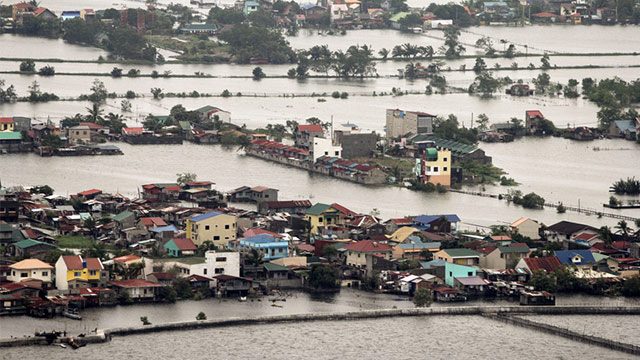SUMMARY
This is AI generated summarization, which may have errors. For context, always refer to the full article.

SUBIC, Philippines – Over 117,000 persons from 20 municipalities of 6 provinces in Central Luzon were displaced as a result of the rains and flooding from Typhoon Mario and the southwest monsoon.
According to regional director Adelina Apostol, “the highest number of displaced population recorded was in the province of Bulacan with 82,508 displaced people or 16,645 families. The others were in the province of Tarlac with 13,947 persons or 3,895 families; Nueva Ecija, 14,267 persons or 1,867 families; and Pampanga with 5,494 persons or 1,363 families; Zambales, 1,018 persons or 262 families; and Bataan with 197 persons or 43 families.”
Apostol added that more reports from the field may increase the number further. “The data may still increase because other remote areas in the coastal part have yet to report their status due to some challenges in transportation and communication,” said Apostol.
“I am encouraging village officials to assist the DSWD in monitoring and collating the number of affected families in remote areas of their jurisdiction,” she added.
The Philippine Red Cross’ preparations
Meanwhile, Philippine Red Cross Chairman Richard Gordon said that, at the height of the rains, amphibious vehicles of the Red Cross were deployed in Marikina and Quezon city, areas heavily affected by flooding.
“The amphibious vehicles act like motherships that can collect a large number of people, and our rescue boats go inside alleys and streets to rescue people, so trapped residents can be taken to dry land and brought to to evacuation centers”. Gordon said.
So far, over 600 people have been rescued by the Red Cross. The number included pregnant women who were about to give birth, and were able to get to nearby hospitals with the help of the amphibious vehicles.
Once the evacuations started, Gordon ordered that hot meals be brought to the sites, and over 6,000 individuals have been served with food and water in Quezon City, Manila, Pasay and Valenzuela evacuation centers.
Welfare desks and first aid stations were also put up for residents to get medical attention and care from volunteer doctors and nurses.
As clean-up efforts got underway, Gordon also called on 143 volunteers from Typhoon Mario affected areas to help clear debris and hose down streets and roads to ensure the safe passage of pedestrians and motorists.
Pre-positioned for eventualities
Philippine Red Cross Secretary Gwendolyn Pang said that over 390 volunteers and 66 staff were deployed and mobilized for rescue and relief operations, and PRC emergency response units (ERUs) and emergency response vehicles such as rubber boats, amphibians, rescue trucks and ambulances which were pre-positioned before the storm hit made a huge difference in response efforts.
Pang also said that communities affected by typhoon Mario “will receive our assistance and support long after this typhoon has passed.”
She added that the PRC Social Services has already deployed social workers to man 13 welfare desks to deliver its psychosocial support program. Over 1,500 individuals have also been reached by hygiene promotion activities.
Pang also directed all nearby chapters that were not affected by typhoon Mario to provide all support needed by affected chapters.
For her part, Apostol said the DSWD Field Office III has already provided support to the affected families, particularly those who are temporarily staying in the evacuation centers in Central Luzon.
She said at least P1.9-million worth of relief goods have already distributed in various temporary shelters in the region. She also said P1.2 million of the fund assistance came from the DSWD field office, while P825,095.00 came from the local government unitsof affected provinces and municipalities.
As part of its preparation, Apostol also said that the Field Office had stepped-up its stock pile of family food packs and non-food items. Some 7,154 family food packs are prepositioned in the 7 provinces of the region, to be managed by the Social Welfare and Development (SWAD) teams. – Rappler.com
Add a comment
How does this make you feel?
There are no comments yet. Add your comment to start the conversation.